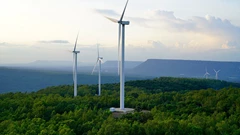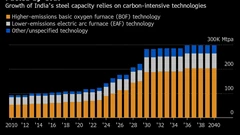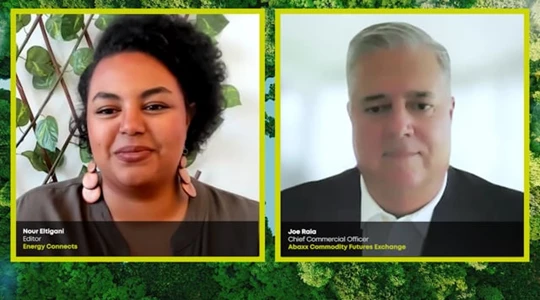Biden Whittles Offshore Oil Leasing Plan to Record-Low Level
(Bloomberg) -- The Biden administration unveiled plans Friday to hold three auctions for offshore drilling rights over the next five years — angering both climate activists pushing to end the practice and oil industry advocates who want more sales.
The blueprint calls for the fewest number of oil and gas lease sales ever offered in a five-year plan by the US, with Gulf of Mexico auctions in 2025, 2027 and 2029. The Interior Department said it set the number in an effort to comply with last year’s climate law, which makes selling drilling rights a prerequisite to issuing leases for offshore wind farms.
“These three proposed lease sales are the minimum number that will enable the Interior Department to continue to expand its offshore wind leasing program through 2030,” the agency said in a release.

The schedule of auctions represents the latest attempt by President Joe Biden to balance competing climate and energy priorities while navigating within the bounds of federal laws meant to promote fossil fuels.
On the campaign trail, Biden promised to confront climate change and ban new oil and gas permitting on public lands and waters. But a 1953 law requires the government maintain an offshore oil and gas leasing program to “best meet national energy needs,” while considering the environment and the needs of states and corporations.
Last year’s climate law goes further, blocking the Interior Department from issuing new offshore wind leases unless it held an oil lease sale with at least 60 million acres up for grabs in the prior year.
Many environmentalists argue even one more offshore oil auction is too many, saying the move will undermine the need to urgently cut greenhouse gas emissions and avert the worst consequences of climate change. Offering more leases to drill also prolongs the peril for Gulf Coast communities “on the front lines of climate change,” Sierra Club Executive Director Ben Jealous said.
Environmentalists unsuccessfully argued that ending oil and gas leasing wouldn’t thwart goals to build offshore wind farms. The US government has already issued nearly 35 commercial wind leases in federal waters, which is sufficient to achieve the Biden administration’s goal of deploying 30 gigawatts of capacity, Earthjustice said.
The group’s president, Abigail Dillen, criticized the plan as “a crucial missed opportunity.” “We are too far along in the climate crisis to be committing ourselves to decades of new fossil fuel extraction,” she said.
Oil industry leaders and their advocates on Capitol Hill called the plan anemic, arguing more leasing is needed to sustain production in the Gulf of Mexico, home to about 15% of US crude output. Because it can take years for companies to find and extract oil from newly sold tracts, leasing now helps sustain production for decades to come.
Rising oil prices — nearing $100 a barrel — underscore the need for continued development, industry advocates said.
Erik Milito, head of the National Ocean Industries Association, said the Biden blueprint “ignores our energy realities” and global demand that’s “continuing to rise.”
Mike Sommers, president of the American Petroleum Institute, said Biden had offered a “restrictive” program that’s part of “a coordinated strategy to reduce energy production, ultimately weakening America’s energy dominance, limiting consumers access to affordable reliable energy and compromising our ability to lead on the global stage.”
Earlier: US Government Ordered to Expand Gulf of Mexico Oil Auction
Senator Joe Manchin, the Democrat from West Virginia who secured the climate law mandate linking offshore wind and oil leasing, also panned the administration’s plan.
“It makes no sense at all to actively be limiting our energy production while our adversaries are weaponizing energy around the world,” Manchin said. “This is a failure of leadership.”
The plan is subject to a 60-day waiting period before it can be formally approved, giving Congress a chance to advance legislation seeking changes. Senator Bill Cassidy, a Republican from Louisiana, is already pushing a bill to compel four offshore lease sales over the next two years.
Interior Secretary Deb Haaland said the schedule reflects a Biden administration commitment “to building a clean energy future that ensures America’s energy independence.”
The Biden administration indicated that the planned sales could be shrunk even further, saying there’s “flexibility” to narrow available acreage, remove sensitive areas and offer only the highest-potential territory once individual auctions are scheduled.
In recent years, parcels in the Gulf generally have been sold twice each year. The government is still on track to auction oil leases across some 73 million acres of the Gulf by Nov. 8, in a sale first scheduled by President Barack Obama and subsequently mandated by the Inflation Reduction Act.
Biden’s Interior Department last year proposed as many as 11 sales — with 10 in the Gulf and one in Alaska’s Cook Inlet — matching the number under the previous, Obama schedule. The final program is a marked reduction from the 47 potential sales of territory along almost every coast that had been outlined by former President Donald Trump.
(Updates with plan details and comments from Sen. Manchin, others, starting in the eighth paragraph.)
©2023 Bloomberg L.P.
KEEPING THE ENERGY INDUSTRY CONNECTED
Subscribe to our newsletter and get the best of Energy Connects directly to your inbox each week.
By subscribing, you agree to the processing of your personal data by dmg events as described in the Privacy Policy.
More renewables news

WEC Energy Offered $2.5 Billion US Loan for Renewable Projects

With Trump Looming, Biden’s Green Bank Moves to Close Billions in Deals

GE Vernova Expects More Trouble for Struggling Offshore Wind Industry

Climate Tech Funds See Cash Pile Rise to $86 Billion as Investing Slows

GE Vernova to Power City-Sized Data Centers With Gas as AI Demand Soars

Longi Delays Solar Module Plant in China as Sector Struggles

Australia Picks BP, Neoen Projects in Biggest Renewables Tender

SSE Plans £22 Billion Investment to Bolster Scotland’s Grid

A Booming and Coal-Heavy Steel Sector Risks India’s Green Goals
















